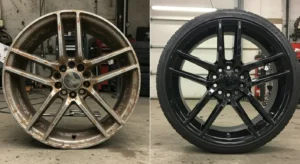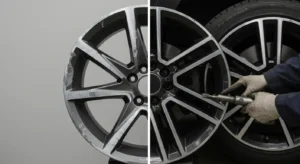In automotive aesthetics, wheel polishing stands out as a transformative process that adds a touch of brilliance to your vehicle. Whether you’re a car enthusiast or looking to enhance your ride’s visual appeal, understanding the art of rim refinishing and the types of wheels that can undergo this process is essential.
This comprehensive guide delves into rim refinishing, shedding light on the various types of wheels that can be polished to perfection.
Understanding Alloy Wheel Buffing
Alloy Wheel Buffing is a meticulous process to enhance the aesthetic appeal and overall longevity of automotive wheels. This technique involves the removal of imperfections, such as oxidation, road grime, and scratches, from the wheel’s surface through a series of abrasive actions.
Typically performed on alloy or aluminum wheels, alloy wheel buffing aims to restore the original luster and shine of the wheels, imparting a renewed vibrancy to the vehicle’s appearance.
The process often begins with thoroughly cleaning to eliminate contaminants, followed by abrasive techniques like sanding or buffing to smooth out surface irregularities. Polishing compounds are then applied to refine the finish and create a glossy, reflective surface.
Understanding wheel shine enhancement is crucial not only for cosmetic reasons but also for preserving the structural integrity of the wheels, as a well-maintained surface is less susceptible to corrosion and damage from environmental elements.
Read more: How Long Does Vinyl Wrap Last?
Types of Wheels Suitable for Polishing
Here are different types of wheels suitable for wheel polishing;
Aluminum Wheels
Aluminum wheels are popular for polishing due to their lightweight nature and corrosion-resistant properties. Polishing aluminum wheels restores their original luster and helps prevent oxidation.
Chrome Wheels
Chrome wheels are renowned for their sleek and shiny appearance. However, they can lose their luster over time due to exposure to harsh elements. Wheel shine enhancement is an effective way to revive the brilliance of chrome wheels, making them stand out once again.
Forged Wheels
Forged wheels, known for their strength and durability, are often made from aluminum or magnesium alloys. Polishing these wheels enhances their visual appeal and brings out the unique patterns and textures inherent in the forging process.
Stainless Steel Wheels
Stainless steel wheels are resistant to rust and corrosion, making them a durable choice for various vehicles. Polishing stainless steel wheels removes surface imperfections and creates a stunning mirror-like finish.
Mag Wheels
Magnesium alloy wheels, commonly called mag wheels, are prized for their lightweight and high-performance characteristics. Polishing mag wheels not only contributes to their aesthetics but also helps in maintaining their structural integrity.
Methods Used for Wheel Shine Enhancement
The following are the methods used for wheel shine enhancement;
Hand Polishing
Polishing Compounds: Use a suitable metal wheel polishing compound and a soft cloth or applicator pad. Apply the compound to the wheel surface and rub it in a circular motion until the desired shine is achieved.
Polishing Balls: Some detailing enthusiasts use polishing balls that can be attached to a drill or a rotary tool for more efficient hand polishing.
Machine Polishing
Polishing Machines: Electric polishers or buffers equipped with foam or wool pads can be used to polish wheels. Ensure the machine has adjustable speed settings and use a suitable polishing compound.
Dual-Action Polishers: These machines oscillate and rotate simultaneously, effectively polishing without the risk of burning the wheel’s surface.
Abrasive Pads and Sanding
For more severe damage, you may start with abrasive pads or sandpaper to remove deep scratches or corrosion. Begin with a coarser grit and progressively move to finer grits for a smoother finish. Wet sanding can be done with water and a lubricant to prevent overheating and to achieve a better finish.
Polishing Wheels with a Drill
Attach a polishing wheel or foam pad to a drill and use a polishing compound. Move the drill in circular motions over the wheel surface, applying even pressure.
Chemical Wheel Cleaners
Some wheel cleaners contain chemical agents that help break down contaminants and oxidation. Follow the manufacturer’s guidelines for applying the cleaner, agitate the surface with a brush, and rinse as directed.
Protective Coatings
After polishing, consider applying a protective wheel sealant or coating to help prevent future oxidation and make cleaning easier.
Professional Metal Wheel Polishing Services
Professional detailers may offer specialized metal wheel polishing services using advanced equipment and techniques. It is beneficial for highly polished or intricate wheel designs.
Conclusion
In automotive customization, wheel restoration is a standout technique that can breathe new life into your vehicle’s appearance. The art of wheel restoration knows no bounds, from aluminum and chrome to forged and stainless steel wheels.
By understanding the types of wheels suitable for polishing, you can embark on a journey to transform your ride into a true masterpiece. So, whether you’re a car enthusiast or someone looking to elevate your vehicle’s aesthetics, consider wheel restoration as the key to unlocking a world of brilliance on the road.
Ready for a wheel makeover? Our expert polishing services cater to all types. Drive in style – reach out to NYC Wheel Professionals today to schedule your wheel transformation!









